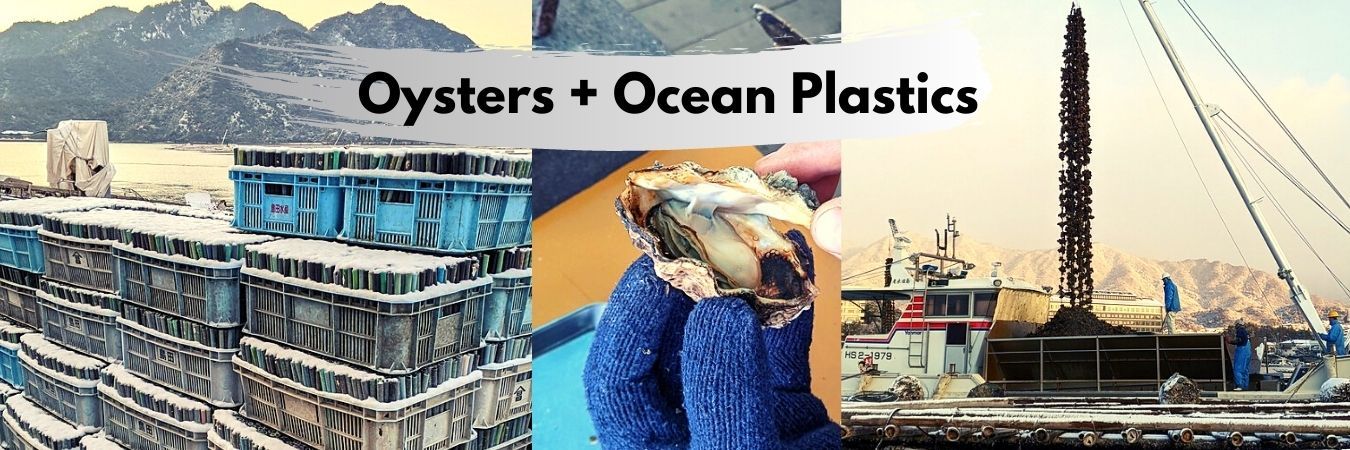 On a freezing cold February morning, I find myself sitting on an oyster boat pulled up next to an oyster float being processed. We are on the calm stretch of sea between Miyajima and the main island area of Hatsukaichi. My hands are numb, but I feel less cold somehow as I watch the crew pulling huge, 4-year old strands of oysters from the sea and cutting the strands at key points to release the oysters onto the boat. It was quite an impressive sight and I find myself admiring the work ethic of the crew plunging their arms into freezing waters at 6am- this is not an easy job!
On a freezing cold February morning, I find myself sitting on an oyster boat pulled up next to an oyster float being processed. We are on the calm stretch of sea between Miyajima and the main island area of Hatsukaichi. My hands are numb, but I feel less cold somehow as I watch the crew pulling huge, 4-year old strands of oysters from the sea and cutting the strands at key points to release the oysters onto the boat. It was quite an impressive sight and I find myself admiring the work ethic of the crew plunging their arms into freezing waters at 6am- this is not an easy job!
The longer I watched the process, however, the more plastic tubes and discs I saw falling amongst the oysters into the pile. Although sleepy when we arrived, I also noticed the snow-covered plastic tubes stacked tidily into craters on the docks we walked past when we boarded the boats.
For the last ten years, I've been an avid beach and river clean-up volunteer, so I am very familiar with these plastic tubes and discs. We have filled countless bags of these same plastic tubes over the years at cleanups and have long suspected that we are only taking a tiny percentage out of the waterways. I now see proof of the claims that each floating oyster bed has 17,000 plastic tubes in use. What I didn’t know is that the oysters grow for 4 years before harvest. So, any new plastics put in with the shells and seeds won’t come out of the sea until 2025.

It’s estimated that at least 100,000 tubes are shaken loose from the floating oyster beds each year due to boat collisions or tidal flows, but I suspect that is a low estimate. I actually broke down and cried once after one of our big beach clean-ups on Ganne Beach in Hiroshima. We had just filled 30 bags to the brim of plastic tubes, discs, and pieces of styrofoam that covered the beach. Most plastics were clearly from the oyster floats, but we were enthusiastic and hardworking and in about 6 hours with our small passionate crew of volunteers, we felt we had accomplished a lot.
It felt great to get so much the plastic off the beach and out of the ocean. But what brought tears to my eyes was going back to the beach when I thought we were done and watching the little kids playing and swimming in the next wave of plastics brought in by the tide. Despite our efforts, within an hour it looked like we hadn’t even been there at all. It’s embarrassing to show so much honest emotion on a video, but it’s how I experienced that day- not jaded or cold to it – my feelings were very raw and I decided it was good to show that side of it.
Of course, the best time to stop putting plastics in the ocean is 10 years ago- but what can we do now?
In the last ten years, I have only seen the problem getting worse and there seems to be no penalties or regulations on the industry from government, and no concerns from the restaurants and consumers about the problem. I found an old clip of my daughter aged 4 yelling at a passing boat- “hey you lost some of your tubes!” as she held up some of the plastic tubes in her hands. It was so cute and we all laughed in the video, but now watching it ten years later, it seems much less endearing.
I have a lot of respect the role that the oyster industry plays in Japan to support the economy and provide employment. Oysters also have a useful cleaning function in terms of cleaning the sea of pollutants. But, there is a blatant disregard for the plastic pollution problem which won’t change until there is regulation in the industry, from the government as well as pressure from consumers.
